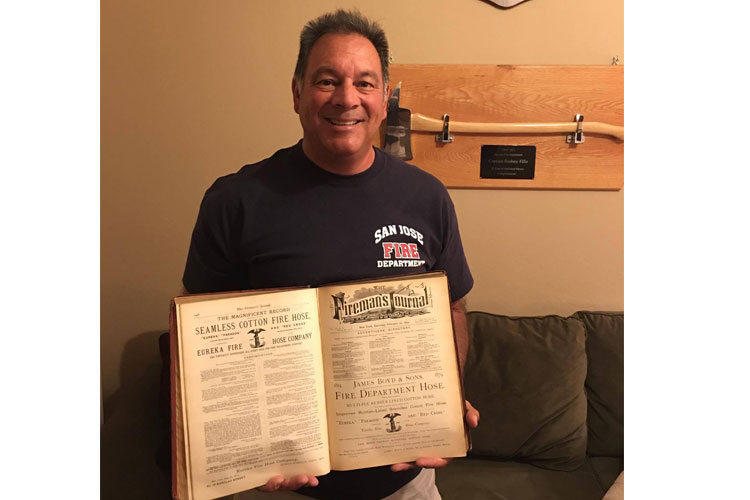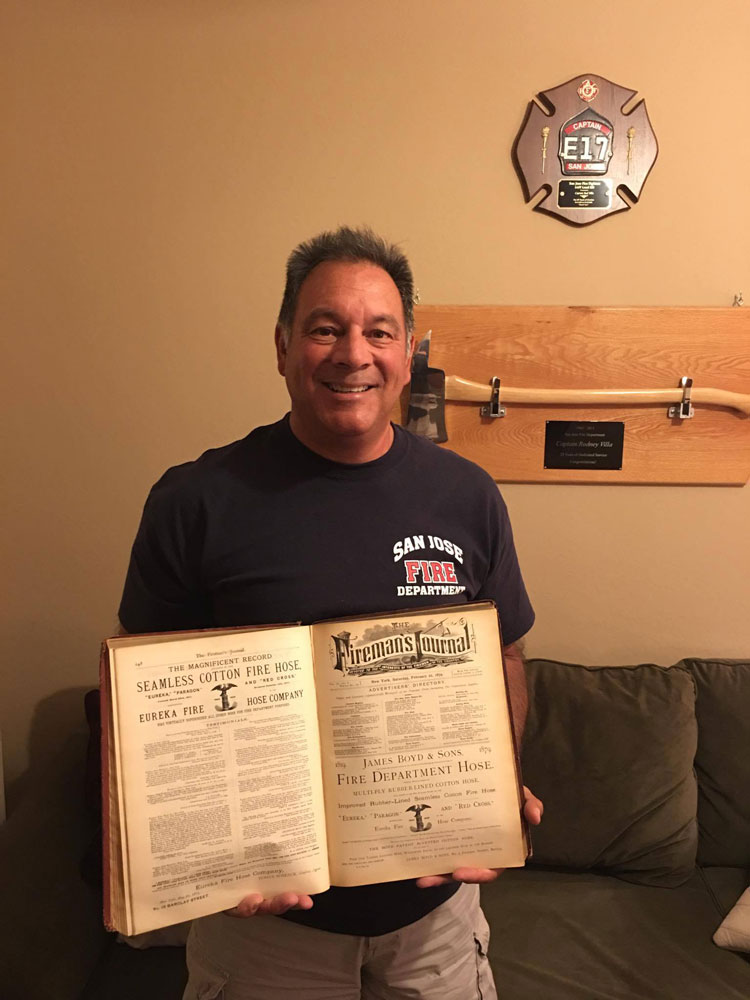

Earlier this year we asked our readers to pose with their oldest issue of Fire Engineering and post the photos on social media. The winner would be featured in an upcoming print issue of Fire Engineering magazine. Rodney Villa, pictured above, was the winner. Below are Rod’s thoughts about Fire Engineering, his fire service career, and the fire service. Thanks to everyone who participated!
Above, Rod pictured with his bound edition of Fireman’s Journal (later Fire Engineering) is Volume III which begins with Saturday January 4, 1879 Volume III No. 1 and runs thru Saturday June 28, 1879, Volume III, No.26. It contains 530 pages.
I am 58 years old and have been involved in the fire service for most of my life. My older brother was a firefighter and I wanted to follow in his footsteps. In 1973, I joined the Boy Scouts of America’s Career Explorer Program when I was 14 years old. The program was sponsored by the Campbell Fire Department in Campbell, California. We were given the opportunity to learn about the tools and equipment, apparatus, and work duties, and got a taste of station life associated with the fire service. It was there that I began to love the history of the fire service. We conducted training drills, learned first aid and CPR, and I went on to become an EMT through our local community college while I was still in high school. While spending time at the fire stations, I started reading my first copies of Fire Engineering Magazine. I enjoyed the fire reports and fire news from around the country. One day, I tore out a subscription card, filled it out and sent it in to Fire Engineering magazine to start receiving my own subscription at home.
After four years in the Explorers I graduated from high school and joined the United States Air Force, where I attended my first Fire Training School at Chanute Air Force Base in Illinois. After training, I was assigned to Lackland AFB in San Antonio, Texas, as a fire protection specialist. I met a fellow airman there whose father had been a photographer for a fire apparatus manufacturing company and had taken all of the companies’ pictures of their line of apparatus. He gave me a box of more than 200 photos of old apparatus dating back to the 1940s. In 1979, I was reassigned to RAF Lakenheath, an Air Force base in the United Kingdom. While in England, I met many local Firefighters and fire buffs. With their help, I started collecting fire service memorabilia, with a special interest in fire helmets.
One of my fire buff friends had a special interest in fire apparatus from around the world. I told him about my collection of apparatus photos and he offered up an exchange of items. He had an 1879 bound edition of the “Fireman’s Journal” that he said I should have since I was an American. He said it would probably mean more to me than to him. He never explained to me where he had obtained it. I have spent a lot of time looking through this wonderful old book. I have always been a bit of an artist and used this book with its great drawings of apparatus and fire equipment to make my own pen and pencil copies of apparatus like horse drawn steamers, hose carts, and hand pumpers. For many years, I had these drawings framed and hanging in my home. Also, my fire helmet collection grew to about 12 helmets by the time my enlistment was over at the end of 1981.
I started testing for the fire service as soon as I could and in 1982 I landed a position as a fire protection specialist at Lockheed Missiles and Space Company in Sunnyvale, California. I worked at Lockheed FD while testing in cities around the state of California. I was lucky enough to get hired at my dream job and became a firefighter in my hometown with the City of San Jose, California. I was hired into the San Jose Fire Department in October 1986 and my career took off. Within a few years, I was promoted to fire engineer, and later I was promoted to fire captain. While in the Air Force I had attended the USAF’s Rescue School, where I received training in all manners of technical search and rescue techniques. With my Air Force background, I took a special interest in technical rescue and helped establish our department’s Urban Search and Rescue (USAR) team. I became one of our senior instructors for the unit and was certified as a senior instructor in confined space rescue, trench rescue, rescue systems I & II, high-angle and low-angle rope rescue, and swift water rescue.
My fire helmet collection started to expand and in September 1989 I was asked to display them at a local theme park in Santa Clara, California, for Fire Prevention Week. At that time I had about 20 helmets. I took them out for display and had a lot of interest in them from the public. For the next 14 years I returned every Fire Prevention Week and put them on display. Needless to say, the collection also grew. By the end of my last year of participation I had 86 helmets from all over the world. Some were newer versions and many were old and antique. My oldest two are an H.T. Gratacap from approximately 1840’s era and a Brass Victorian from England dated 1886.
In 1999, I became a member of FEMA Urban Search and Rescue California Task Force 3 based out of Menlo Park, California. I soon was certified as a FEMA Rescue Instructor and after the attacks on the World Trade Center on September 11th, I deployed with CATF-3 to New York City to assist with Search and Recovery operations.
I spent 14 years as an officer assigned to Special Operations- USAR unit. I later transferred to an Engine company that operated out of a new station only a few blocks from my home in San Jose. After 25 years in the San Jose Fire Department and a total of 34 years in the fire service (not counting my four years as a Fire Explorer), I retired from the fire service.
Unfortunately, with retirement also came a move out of state. With our relocation to Arizona, I had to downsize my helmet collection before the move. I was able to retain my most prized and favorite helmets. I currently have 30 helmets left to enjoy.
For many years, I had subscribed to Fire Engineering Magazine. I had read and saved every issue from 1973 to about 1989. I had about 200 issues stored in an old footlocker. I finally had to let them go. But for many years after, I have always looked forward to my next issue to arrive in the mail. Currently I receive my Fire Engineering online via email. Fire Engineering magazine is still the best source of Fire News from around the country and the world. Happy 140th Birthday Fire Engineering magazine!
Career Highlights
1973 to 1977 Fire Explorer in BSA Explorer Post 345, Campbell FD, California
1977 to 1981 US Air Force Fire Protection Specialist, Rescueman
1982 to 1986 Fire Protection Specalist – Lockheed Missiles and Space Company,
Sunnyvale, California
1986 to 2011 San Jose Fire Department, San Jose, California
Firefighter
Fire Engineer
Fire Captain
1999 to 2011 Member of FEMA California Task Force 3 Urban Search and Rescue
Retired in 2011

